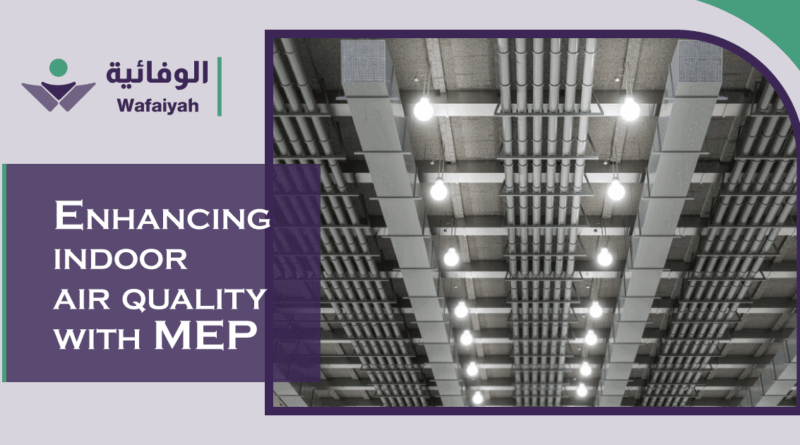Enhancing Indoor Air Quality With MEP
MEP (Mechanical, Electrical, and Plumbing) provision in buildings is very much important for the overall comfort of occupants. Indoor air quality is of prime importance. Considering the atmospheric air of our globe, it is very much evident that energy efficient and the latest MEP designs are top priorities to include during the construction of buildings. The indoor air quality can be three to five times more polluted than the outdoor air quality. In the Middle East, where individuals spend approximately 90% of their time indoors due to extreme climatic conditions, the quality of indoor air becomes an even more pressing concern.
Specifically talking about Saudi Arabia, they are very much interested in the latest and top-class MEP designs to employ in their construction to reduce the overall carbon footprint of the country.
Indoor air quality is a very concerning factor since occupants of different ages are residing in the building and their oxygen levels should be maintained for a healthy life. Before delving into the impact of MEP design, it’s essential to understand what constitutes indoor air quality. IAQ refers to the quality of the air within and around buildings, especially as it relates to the health and comfort of occupants. Poor IAQ can lead to various health issues, including respiratory problems, allergies, and fatigue, while also affecting cognitive function and overall well-being.
IAQ (Indoor Air Quality) Influenced by MEP Design
HVAC (Heating, Ventilation, and Air Conditioning) systems are one of the crucial central mediums from which many unwanted pollutants can be eliminated and stopped from entering the building. A proper design of an HVAC system is a very deciding factor in controlling the building temperature, air infiltration, and other factors that are responsible for disrupting the overall comfort of occupants. Key factors influencing IAQ include
Air Filtration
High-efficiency filters can effectively remove airborne contaminants such as dust, pollen, and pollutants, thereby improving IAQ. When it comes to indoor air quality, achieving optimal thermal comfort and air distribution is key. This is where MEP (Mechanical, Electrical, Plumbing) design plays a vital role. MEP design encompasses the systems that control the heating, ventilation, and air conditioning in a building, ensuring that occupants can breathe easily and enjoy a comfortable environment.
Ventilation
MEP designs must incorporate fresh outdoor air to exchange from indoor heat thereby eliminating indoor unhealthy pollutants. A well-calculated air quality index must be checked in the design of MEP systems.
An MEP design should be such that it should have dedicated humidity control procedures. Indoor humidity if present in excess also makes accounts for the accumulation mold of pollutants.
Building Envelope
The building envelope which includes insulation, air-tight closures, and air-discharging units should be well insulated.
MEP systems should be designed such that high-quality insulation panels are necessary for provision in the building plan. A well-insulated and tightly sealed building envelope helps prevent the infiltration of outdoor pollutants and maintains consistent indoor environmental conditions, reducing the workload on HVAC systems and enhancing IAQ.
Plumbing Systems
Plumbing Designs can impact indoor air quality to a great extent. Using the latest techniques and standards in plumbing systems is necessary to avoid the accumulation of contaminated water. It also helps in the avoidance of unwanted particles and microbial activities that might be possible in plumbing systems. Good quality microorganism resistance can also be employed in the cleaning activities of plumbing systems.
Strategies for Optimizing IAQ through MEP Design
Collaboration among architects, MEP engineers, and other stakeholders from the early stages of design is essential for addressing IAQ concerns comprehensively. An integrated design approach allows for the identification of synergies and trade-offs among various design elements to achieve optimal IAQ outcomes.
Low VOC (Volatile Organic Compounds)
The usage of low volatile organic compounds in the interior finishing of buildings helps in maintaining indoor air quality since the type of materials and finishes play a huge role in controlling the overall indoor air quality experience.
Specifying low-VOC or VOC-free materials during the design phase helps minimize indoor air contaminants and improves IAQ.
Impacts of Poor Indoor Air Quality
Poor indoor air quality can have a major impact on health, particularly for those who spend a lot of time indoors, such as office workers, students, and the elderly. Health issues related to poor indoor air quality can range from minor irritations to serious illnesses.
One of the most common health effects of poor indoor air quality is respiratory issues. When air pollutants are inhaled, they can irritate the lungs and airways, causing symptoms such as coughing, wheezing, and shortness of breath. Long-term exposure to indoor air pollutants can also lead to chronic respiratory diseases such as asthma.
Increase in Operational Costs
Constantly utilizing bad air from HVAC systems for ventilation and air conditioning of the building interior can have massive disruptions in air ducts. It consecutively increases the operational costs of maintenance.
Indoor Air quality is highly dependent on air filters and HVAC systems ducts which are used for ventilation and air conditioning.
Energy efficiency and indoor air quality are two sides of the same coin. One can’t be achieved without the other. MEP design plays a critical role in balancing these two aspects in buildings.
Conclusions
To enhance indoor air quality, MEP designs play a significant part in controlling and making indoor air breathable. Occupant comfort levels are of prime importance to any building owner. Overall, MEP design is a crucial component of creating a healthy indoor environment. By incorporating proper ventilation, humidity control, and eco-friendly systems, MEP designers can help to improve indoor air quality and promote the health and well-being of building occupants. In a state where high temperatures and humidity levels are the norm, it’s important to rely on a professionally designed HVAC system that’s tailored to meet the specific needs of your building. This not only ensures that the indoor environment is comfortable but also that the air quality is healthy for the occupants.


